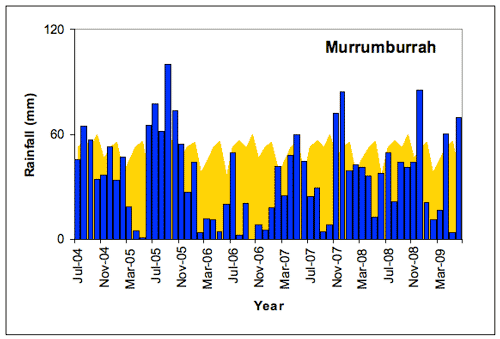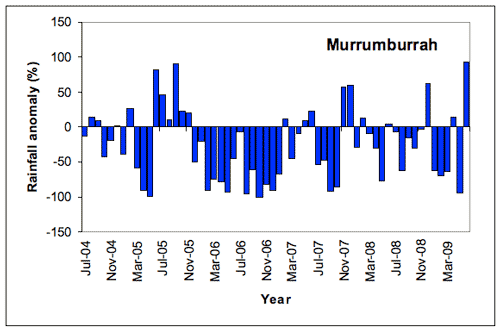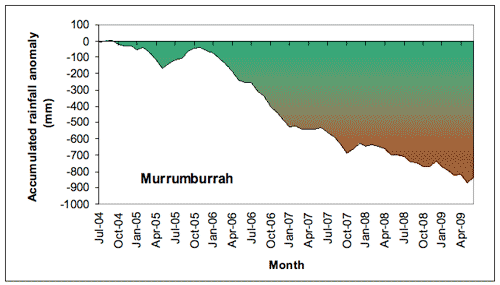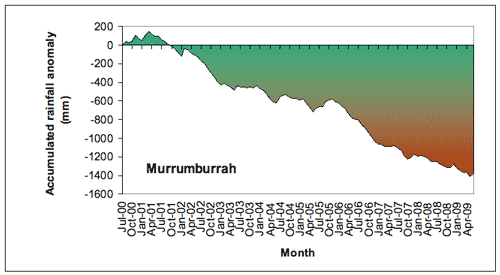Harden
Please note: Text or data highlighted in this colour represent an update to this indicator for the period 2008/09. All rainfall figures have been updated on this page.
Rainfall Analysis
The main rainfall observing site used in this analysis was Murrumburrah Post Office (Bureau of Meteorology Station No. 073029), which has records commencing in 1884. Murrumburrah is 2 km from Harden. Data from nearby stations were used to calculate values for months with missing data at this site (see Appendix 2 for further information).
Note that in the following analyses rainfall totals for individual months or years (where the year is defined as the 12 months from July to June) are compared to the long-term average (or climatology) from 1961-1990. A 30-year period is used to calculate climatological averages to conform with World Meteorological Organisation practice; this takes into account year-to-year variations and less frequent events such as El Niño or La Niña. This particular 30-year period is used internationally as a standard climatological average period.
As shown in the table below, Murrumburrah was drier than average in all five years in the period 2004/05-2008/09. The driest year was 2006/07, when rainfall was 46.2% below the long-term average at 322.4 mm for the year. This was the second driest Jul-Jun 12 month period since the records began in 1884. The wettest year in the last four years was 2005/06, when rainfall was 487.6 mm, which is still 18.7% below the average.
| Rainfall Statistics | Harden (Murrumburrah) | ||||
|---|---|---|---|---|---|
2004/5 |
2005/6 |
2006/7 |
2007/8 |
2008/9 |
|
| Annual Total* (mm) | 461.0 |
487.6 |
322.4 |
430.6 |
466.2 |
| Anomaly (mm) | -138.6 |
-112.0 |
-277.2 |
-169.0 |
-133.4 |
| Anomaly (%) | -23.1 |
-18.7 |
-46.2 |
-28.2 |
-22.2 |
| Mean (1961-1990) (mm) | 599.6 |
||||
*Note: annual totals were calculated for the 12 months July-June.
Monthly Rainfall, 2004-2009
A comparison of monthly rainfall totals with the long-term monthly average rainfall at Murrumburrah (Figure 1) shows that this five year period has been one of very dry conditions with only very short periods of above average rainfall. Above average rainfall was recorded only during the latter half of 2005. The dry conditions during 2006/7 reflect the impact of the El Niño event during this period while the increase in rainfall at the end of 2007 reflected the development of a La Niña event as was the rainfall in November-December 2008. Dry conditions redeveloped during 2008 and apart from one or two isolated months, these conditions persisted into 2009.
 |
Of the 60 months in this period, 40 months (67% of the record) had below-average rainfall at Murrumburrah (Figure 2). The most prolonged dry spell began in December 2006 and extended to October 2007 apart from average rainfall in February, May and June 2007. A dry period also occurred during the period October 2004 to May 2005 apart from average rainfall in December 2004 and February 2005 with another log dry period from January 2008 to May 2009. The driest individual month was October 2006 when no rain was recorded (long term average for October is 59.6 mm) whilst May 2005 only recorded 0.6 mm. Conditions were significantly wetter than normal during June to November 2005 and November and December 2007 while average rainfall was recorded in August, September and December 2004, February 2005 and May and June 2007. The wettest individual month was September 2005 with 100 mm (long term average for September is 52.4 mm).This was the seventh wettest September on record since 1885.
 |
The result of the generally dry conditions at Murrumburrah during the 2004-2009 period is reflected in the accumulated rainfall deficit (Figure 3). While the accumulated deficit was slightly below the norm from July 2004 to October 2005, there was a rapid increase in the deficit during 2006 and 2007 before a slower increase during 2008/9. This reflects the impacts of the El Niño year 2006-7 without a compensating wet period. During the whole period there were 40 months (67%) with rainfall deficits and the total accumulated deficit was 836.7 mm (139 % of the average Jul-Jun rainfall).
 |
The climatological context for rainfall at Murrumburrah
The long-term perspective
As is typical of the region, Murrumburrah has experienced large fluctuations in annual (July-June) rainfall, including several extended periods of above- or below-average rainfall since records began in 1887. In general, annual rainfall was lower and less variable in the late 19th century, followed by a period of greater variability. Rainfall variability has been lower since about 1990 (Figure 4). The recent dry period is reflected in other parts of the long term record such as the late 19th and early part of the 20th Century and the period from the late 1920’s through to the end of World War 2 and the late 1970’s. While to this point in time this recent dry period can only be considered as part of the long term variability in rainfall experienced in the region, the period since 2001 is the longest and driest continuous period on record.
- Rainfall in the late 19th and early 20th century was generally below average (to about 1915), followed by a short wet period. Since then annual rainfall totals have been more variable.
- Several wetter-than-normal years around 1950 and in the mid 1970s produced wetter period then.
- A drier than average period around 1980 was followed by some good rainfall years until the early 1990s. Since about 1993 conditions have been generally drier than average with the period since 2001 being the longest and driest continuous period on record.
The wettest year (July-June) on record was 1949/50 (1056 mm); the driest year was 1896/7 (278 mm).
![Figure 4. Annual (July-June) rainfall at Murrumburrah from 1887/8 to 2008/9 depicted as deviations from the long-term mean. A 5-year running mean is superimposed to highlight wetter and drier periods. [Deviations were calculated as the difference between the rainfall for each year and the mean for the period 1961-1990 (scale in mm).]](../images/harden/rain04.gif) |
Figure 5 indicates the extent of the dry period that has been experienced since 2002 in this region. There was a slight positive accumulation through 2001 with a rapid increase in rainfall deficit through 2002. This decrease persisted through 2003 to 2005 although at a slower rate before increasing again from 2006. This pattern in particular reflects the impacts of the two El Niño years of 2002-3 and 2006-7 without a compensating wet period. During the whole period there were 74 months (69%) of rainfall deficit and the total accumulated deficit was 1380.2 mm (230 % of the average Jul-Jun rainfall).
 |
About the data
